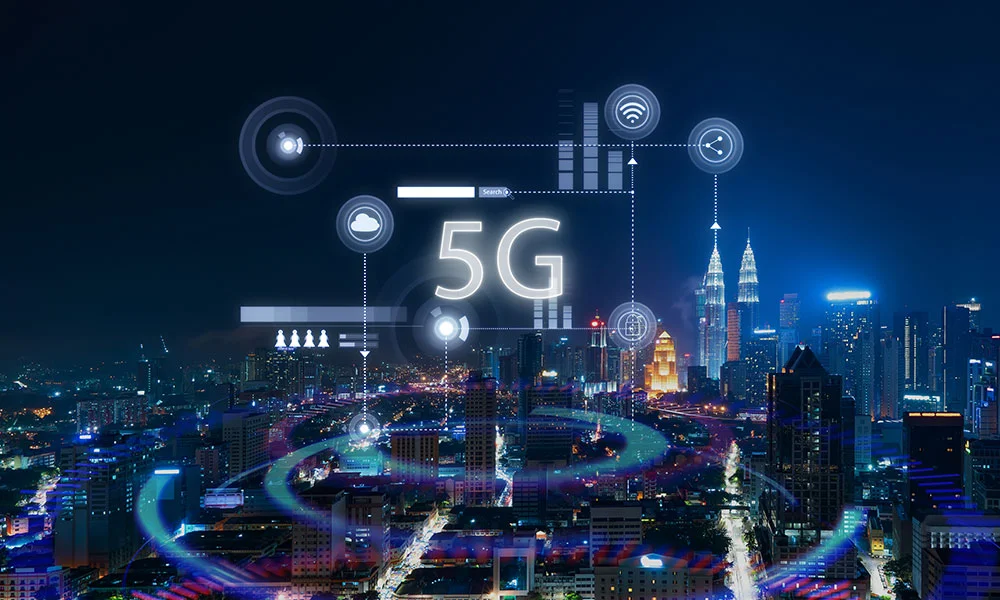Introduction to Li-Fi technology
Imagine a world where your internet connection is as fast as the speed of light—literally. Welcome to the fascinating realm of Li-Fi technology, where visible light takes center stage in communication.
While Wi-Fi has been our trusted companion for wireless connectivity, this innovative approach harnesses the power of LED lights to transmit data at unprecedented speeds.
It’s not just about browsing faster; it’s about unlocking potential we never thought possible. As we dive deeper into what makes Li-Fi so revolutionary, prepare to see how this cutting-edge technology could change the way we connect forever.

How does Li-Fi work?
Li-Fi operates by using visible light to transmit data. Unlike traditional Wi-Fi, which relies on radio waves, Li-Fi utilizes LED lights that flicker at incredibly high speeds. This flickering is imperceptible to the human eye but can convey information.
When you send a signal through an LED bulb, it modulates the intensity of light. The changes in brightness represent binary code—essentially translating 1s and 0s into streams of data. A photodetector then captures these light signals and converts them back into electrical impulses.
This innovative method allows for much faster communication rates compared to conventional wireless technologies. In essence, every LED lamp becomes a potential access point for high-speed internet connectivity.
As long as there’s line-of-sight between the transmitter and receiver, efficient data transfer occurs seamlessly. It opens doors for new applications across various fields where illumination meets communication technology.

Advantages of Li-Fi over Wi-Fi
Li-Fi technology offers several key advantages over traditional Wi-Fi. One of the standout benefits is its ability to transmit data at incredibly high speeds. Utilizing visible light, Li-Fi can achieve data rates significantly faster than current wireless standards.
Another major advantage lies in security. Since Li-Fi transmits information through light beams, it creates a more confined communication channel. This makes it harder for unauthorized users to intercept signals compared to radio waves used in Wi-Fi.
Energy efficiency is also noteworthy. Light sources like LEDs consume less power while still providing robust connectivity, making this technology eco-friendly and cost-effective.
Additionally, Li-Fi can operate in environments where radio frequency communications may struggle or be prohibited, such as hospitals or airplanes. This flexibility opens up new possibilities for seamless connectivity wherever there’s adequate lighting.

The potential applications of Li-Fi
Li-Fi technology opens up a world of possibilities. One of its most exciting applications is in smart homes, where light fixtures can serve as data transmitters. Imagine your ceiling lights streaming high-speed internet to your devices seamlessly.
In healthcare settings, Li-Fi could enhance communication between medical equipment and staff without interference from radio frequencies. This ensures that critical devices operate smoothly while providing real-time updates.
Transportation also stands to benefit enormously. Streetlights equipped with Li-Fi can relay traffic information to vehicles, improving safety and efficiency on the roads.
Moreover, educational environments might utilize Li-Fi for interactive learning experiences. Classrooms could harness visible light for instant access to digital resources while eliminating Wi-Fi congestion issues.
Retail spaces are another promising area; stores may leverage Li-Fi for personalized marketing through lighting systems that target shoppers directly based on their preferences or locations within the store.

Challenges and limitations of Li-Fi
Li-Fi, while promising, faces several challenges that hinder its widespread adoption. One significant limitation is its reliance on visible light. If the light source is blocked or interrupted, data transmission halts.
Moreover, Li-Fi’s range is restricted compared to traditional Wi-Fi networks. It typically operates effectively within a room but struggles in larger spaces without multiple access points.
Another concern involves interference from sunlight or other strong light sources. This can disrupt signals and affect performance.
Additionally, integrating Li-Fi technology into existing infrastructure poses hurdles. Retrofitting buildings with appropriate lighting systems requires time and investment.
Security remains an issue as well; although optical signals are less prone to eavesdropping than radio waves, they can still be intercepted if someone has line-of-sight access to the data stream.
Addressing these complexities will be key for Li-Fi’s future viability in communication technology.

Comparison between Li-Fi and other wireless communication technologies
Li-Fi stands apart from traditional wireless technologies like Wi-Fi and cellular networks. While Wi-Fi relies on radio waves, Li-Fi harnesses visible light for data transmission. This fundamental difference allows Li-Fi to operate in environments where radio frequencies may be restricted or interference-prone.
Speed is another key factor. Li-Fi can potentially deliver faster communication than Wi-Fi, especially when using LED lights that flicker at incredibly high speeds. Consequently, users might experience smoother streaming and quicker downloads.
However, limitations exist. Unlike radio waves that penetrate walls easily, Li-Fi’s reliance on line-of-sight means it struggles with obstacles. This drawback makes it less suitable for all scenarios compared to other wireless technologies that offer more versatility in coverage.
When we look at 5G technology, the comparison deepens further as both aim for high-speed connectivity but approach the challenge differently—Li-Fi focuses on illumination sources while 5G utilizes a network of cell towers for broader reach.

Future prospects and developments in Li-Fi technology
The future of Li-Fi technology holds immense promise. As researchers continue to explore its potential, advancements in light-emitting diodes (LEDs) will play a crucial role. Enhanced LED capabilities can lead to faster data transmission rates.
Integration with existing infrastructure is another exciting avenue. By utilizing streetlights and other lighting systems, cities could create vast networks for seamless connectivity. This would reduce the strain on traditional Wi-Fi networks, especially in crowded areas.
Moreover, the rise of smart devices presents an opportunity for Li-Fi integration. Imagine homes where appliances communicate through visible light rather than radio waves. This could enhance security and efficiency while reducing electromagnetic interference.
In addition, collaboration between tech companies might accelerate development. Partnerships can drive innovation and encourage standardized protocols for wider adoption of this communication technology across industries like healthcare and education.

Conclusion: Is Li-Fi the future of wireless communication?
Li-Fi technology presents an exciting alternative to traditional wireless communication methods. By utilizing visible light, it opens up new possibilities for faster data transmission.
The advantages are compelling. It offers increased bandwidth and enhanced security compared to conventional Wi-Fi. These features could revolutionize various industries, from healthcare to entertainment.
Yet, challenges remain in widespread adoption. Infrastructure needs upgrading, and public awareness is still limited.
Innovative developments continue at a rapid pace. Researchers are exploring ways to integrate Li-Fi into everyday devices like smartphones and laptops.
As the world becomes more connected, technologies like Li-Fi could play an essential role in managing our growing demand for speed and efficiency in communication networks. The future looks bright with potential innovations on the horizon that could transform how we connect digitally.
What is Li-Fi Technology?
Li-Fi technology represents a groundbreaking approach to wireless communication. Using visible light, it enables data transmission at remarkable speeds. Unlike conventional Wi-Fi that relies on radio waves, Li-Fi harnesses the power of LED lights.
Imagine your room filled with bright LEDs, each flickering at an incredibly fast pace—too quick for the human eye to detect. These rapid changes encode data and transmit it seamlessly across distances.
This innovative method transforms ordinary lighting into high-speed internet access points. It opens up new avenues for connectivity in spaces where traditional methods might struggle or cause interference.
As urban environments grow denser, Li-Fi offers a refreshing alternative with its ability to provide faster connections while reducing congestion typically faced by radio frequency technologies.

How does Li-Fi work?
Li-Fi, or Light Fidelity, operates by using visible light to transmit data. Unlike traditional Wi-Fi that relies on radio waves, Li-Fi utilizes LED lights for communication.
When a light source flickers at high speeds—too fast for the human eye to detect—it encodes data into binary format. This rapid modulation allows information to be transmitted seamlessly.
Devices equipped with photodetectors can capture these variations in light intensity. As they receive this input, the devices decode the signal back into usable data.
The technology can achieve incredibly high speeds due to its use of the broad spectrum available within visible light. This potential makes it a game-changer in environments where radio frequencies are less effective.
With indoor spaces becoming increasingly populated with LED lighting, integrating Li-Fi could revolutionize how we connect and communicate wirelessly.

Advantages of Li-Fi over Wi-Fi
Li-Fi offers several advantages over traditional Wi-Fi that could reshape our connectivity landscape. First and foremost, it utilizes visible light for data transmission, making it inherently faster. With the ability to reach speeds up to 100 times faster than Wi-Fi, users can enjoy seamless streaming and quicker downloads.
Another significant benefit is security. Since Li-Fi relies on light waves, it cannot penetrate walls like radio waves do. This means that unauthorized access becomes far more challenging in environments where privacy matters.
Energy efficiency is another highlight of Li-Fi technology. LED lights used for illumination can simultaneously transmit data while consuming minimal energy compared to standard routers.
Moreover, Li-Fi’s ability to function in areas where radio frequency communication fails makes it invaluable in settings like hospitals or aircrafts, ensuring constant connectivity without interference from sensitive equipment.

Potential applications of Li-Fi
Li-Fi technology opens up a world of exciting applications. Imagine using visible light to connect devices in places where radio frequencies struggle, like hospitals or airplanes. This could enhance patient safety and provide uninterrupted service during flights.
Smart homes can benefit significantly as well. With Li-Fi, every bulb can serve as a communication point. Lights could transmit data while maintaining illumination, creating faster networks for streaming media or smart device control.
In education settings, classrooms equipped with Li-Fi can support seamless digital learning experiences. Students may access high-speed internet through their desks’ lighting fixtures without interference from other electronic devices.
Retail environments are also ripe for innovation. Shops could use Li-Fi to deliver personalized content directly to customers’ smartphones based on their location within the store, elevating customer engagement and enhancing the shopping experience.

Current challenges and limitations
Li-Fi technology, while promising, faces notable challenges that hinder its widespread adoption. One significant limitation is the reliance on visible light. This means Li-Fi cannot function in darkness or through obstacles like walls, restricting its usability in various environments.
Another challenge lies in its infrastructure needs. Implementing Li-Fi requires specialized hardware such as photodetectors and LED lights capable of modulation. Transitioning from existing Wi-Fi systems can be costly for businesses.
Interference poses another issue; sunlight and fluorescent lighting can disrupt signals, leading to inconsistent connections.
Moreover, the speed of data transmission can diminish over distance or due to physical barriers. Ensuring a stable connection becomes complex in larger spaces with varying light conditions.
Despite these hurdles, ongoing research aims to address these limitations and unlock the full potential of this innovative communication technology.

Future prospects for Li-Fi technology
Li-Fi technology holds immense promise for the future of communication. With advancements in visible light communication, we may see Li-Fi become mainstream in various settings. Its ability to transmit data faster than traditional methods is a game-changer.
Imagine bustling urban environments where streetlights are not just illuminating pathways but also providing high-speed internet access. This could revolutionize connectivity for smart cities and enhance overall user experience.
Moreover, as industries increasingly rely on automation and IoT devices, Li-Fi can offer secure and efficient networks that reduce interference common with radio frequencies.
Research continues to unveil new applications, from healthcare monitoring systems to educational tools that leverage visual resources effectively. The integration of Li-Fi into everyday life seems not only feasible but imminent as experts push the boundaries of this innovative technology.

Conclusion
The world of communication technology is rapidly evolving, and Li-Fi stands at the forefront of this transformation. With its ability to utilize visible light for data transmission, it presents an innovative alternative to traditional wireless methods like Wi-Fi. The potential benefits are significant: faster speeds, increased security, and a broader range of applications.
Despite some challenges—such as limitations in line-of-sight connectivity and dependence on lighting conditions—the prospects for Li-Fi remain promising. As researchers continue to overcome these hurdles, we may soon see widespread adoption across various sectors.
As technology advances and our need for better communication solutions grows, Li-Fi could very well become a crucial component of our digital landscape. It’s not just about speed; it’s about redefining how we connect with one another through light-based communication systems that enhance our everyday experiences. Whether in homes or businesses, the future looks bright for Li-Fi technology.







